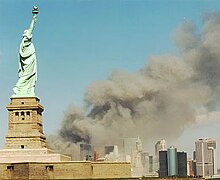User:SerrRuss/sandbox
 | This is a user sandbox of SerrRuss. A user sandbox is a subpage of the user's user page. It serves as a testing spot and page development space for the user and is not an encyclopedia article. |
Plan
[edit]I intend to improve the Racial Profiling page by adding the following edits to both the Support and Criticism sections.

Support
[edit]Supporters defend the practice of racial profiling by emphasizing the crime control model.[1] They claim that the practice is both efficient and ideal due to utilizing the laws of probability in order to determine one’s criminality.[1] This system focuses on controlling crime with swift judgment, bestowing full discretion on police to handle what they perceive as a threat to society.[1] The use and support of racial profiling has surged in recent years, namely in North America due to heightened tension and awareness following the events of 9/11. [2] As a result, the issue of profiling has created a debate that centers on the values of equality and self-defense.[2] Supporters uphold the stance that sacrifices must be made in order to maintain national safety, even if it warrants differential treatment.[2]

Criticism
[edit]Conversely, those in opposition of the police tactic employ the teachings of the due process model, arguing that minorities are not granted equal rights and are thus subject to unjust treatment.[1] In addition, some argue that the singling out of individuals based on their ethnicity comes in violation of the Rule of Law, having voided all instance of neutrality.[2] Those in opposition also make note of the role that the news media plays within the conflict. The general public internalizes much of its knowledge from the media, relying on sources to convey information of events that transpire outside of their immediate domain.[3] In conjunction with this power, media outlets are aware of the public’s intrigue with controversy and have been known to construct headlines that entail moral panic and negativity.
In 2006, 18 young men from the GTA were charged with conspiring to carry out a series of bombings and beheadings, resulting in a swell of media coverage.[3] Two media narratives stood out with the former claiming that a militant subculture was forming within the Islamic community while the latter attributed the case to a bunch of deviant youth who had too much testosterone brewing.[3] Eventually, it was revealed that government officials had been tracking the group for some time, having supplied the youth with the necessary compounds to create explosives, prompting critics to discern whether the whole situation was a set-up.[3] Throughout the case, many factors were put into question but none more than the Muslim community who faced much scrutiny and vitriol due to the build-up of negative headlines stemming from the media.[3]
Notes
[edit]- ^ a b c d Goff, Colin (2014). Criminal Justice in Canada (6th ed.). Toronto, ON: Nelson Education. pp. 180–187.
- ^ a b c d Thomson Gale (2006). Racial Profiling. Farmington Hill, MI: Greenhaven Press. pp. 71–79.
- ^ a b c d e Fleras, Augie (2011). The Media Gaze: Representations of DIversities in Canada. Vancouver, BC: UBC Press. pp. 25–33.
